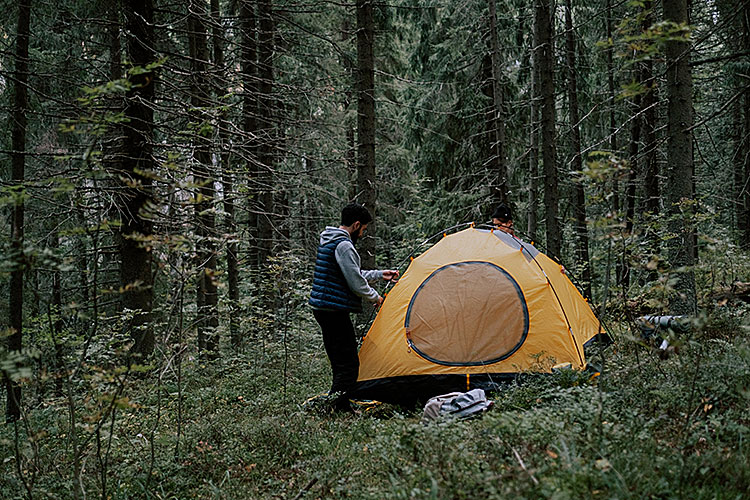On June 25, residents from rural Bonny Doon, devastated by the 2020 CZU wildfire, which destroyed 897 homes in Santa Cruz County, came out in droves to oppose a proposed county ordinance on “low-impact” camping. They wanted high-fire risk areas excluded. They had concerns about poop in the woods, noise from generators, and who would enforce the law when the rules were broken.
“The fire gods know no political boundaries,” he said.
There is no regulation requiring permits for upscale HipCamp operators.
HipCamp.com lists camping sites for tents and RVs, 14 acres in Felton, $45 a night, Redwood Paradise, 40 acres in Santa Cruz, bordering Wilder Ranch State Park, $65 a night, and a cottage, cabin, and 2 tent sites among redwood trees on 16 acres, $75 a night.
Supervisor Zach Friend thought it would make sense to have a regulatory framework for these operations suitable for the local environment as the state Legislature is considering a broader regulation from Sen. Mike McGuire (D-Ukiah) allowing “low impact camping” statewide.
That is SB 620, Supervisor Bruce McPherson noted.
After hearing a deluge of reservations, supervisors unanimously agreed to do an initial environmental study of a proposal to limit the number of sites to 150, cap the number of vehicles at 2, require on-site management, assuming SB 620 passes.
Here is what is posted online about SB 620:
••
The people of the State of California do enact as follows:
SECTION 1.Section 18862.43 of the Health and Safety Code is amended to read:18862.43.
Special occupancy park means a recreational vehicle park, temporary recreational vehicle park, incidental camping area, or tent camp. Special occupancy park does not include a low-impact camping area, as defined in Section 18890.
SEC. 2.Part 2.3.5 (commencing with Section 18890) is added to Division 13 of the Health and Safety Code, to read:2.3.5.LOW-IMPACT CAMPING18890.
(a)Low-impact camping area means any area of private property that provides for the transient occupancy rental of a temporary sleeping accommodation for recreational purposes that is not a commercial lodging facility and meets all of the following requirements:
(1)Provides for the transient occupancy rental of a temporary sleeping accommodation, not exceeding 14 consecutive nights per camper and not exceeding 28 nights per calendar year per camper.
(2)Includes no more than nine temporary sleeping accommodations.
(3)Does not include a temporary sleeping accommodation that is rented out for permanent human occupancy.
(4)Does not allow for onstreet parking.
(5)Complies with applicable state and local fire safety requirements.
(6)Complies with applicable state and local tax requirements, including, but not limited to, the payment of local transient occupancy taxes.
(7)Complies with applicable local requirements for disposal of human waste, or in the absence of applicable local requirements, maintains sanitation facilities that are fully self-contained or connected to a permitted sewage disposal system serving the property.
(8)Complies with applicable local requirements for disposal of trash, or in the absence of applicable local requirements, requires all solid waste to be removed from the premises after each occupancy and onsite trash receptacles to abide by applicable animal-protection trash best practices or requirements.
(9)Complies with applicable local requirements for quiet hours, or in the absence of applicable local requirements, enforces quiet hours from 10 p.m. to 6 a.m.
(10)Complies with applicable local requirements relating to low-impact campsites, low-incident camping, or incidental camping. camping, including, but not limited to, local zoning, permit, lot size, and setback requirements.
(11)Designates an operator or property manager who is available by phone 24 hours a day, seven days a week.
(12)Is not located within a single-family residential zone. (13)
(12)Is not located on a site that meets both of the following:
(A)A site that is a legal parcel or parcels located in a city if, and only if, the city boundaries include some portion of either an urbanized area or urban cluster, as designated by the United States Census Bureau, or, for unincorporated areas, a legal parcel or parcels wholly within the boundaries of an urbanized area or urban cluster, as designated by the United States Census Bureau.
(B)A site in which at least 75 percent of the perimeter of the site adjoins parcels that are developed with urban uses. For purposes of this paragraph, parcels that are separated only by a street or highway shall be considered to be adjoined.
(14)
(13)Has not been used as a special occupancy park for the last five years unless both of the following are true:
(A)The area was a special occupancy park before January 1, 2024.
(B)The area met the requirements of this subdivision on January 1, 2023.
(b)For purposes of this section, the following definitions apply:
(1)Commercial lodging facility has the same meaning as the term hotel is defined in subdivision (a) of Section 1865 of the Civil Code.
(2)Recreational vehicle has the same meaning as that term is defined in Section 18010.
(3)Temporary sleeping accommodation includes, but is not limited to, a tent, yurt, or recreational vehicle.
(c)This section does not authorize an individual to access private property without the permission of the landowner.
18891.
In the absence of applicable local requirements, the county in which the low-impact camping area is located may shall enforce the minimum requirements described in paragraphs (7) to (9), inclusive, of subdivision (a) of Section 18890.
SEC. 3.
No reimbursement is required by this act pursuant to Section 6 of Article XIIIB of the California Constitution because a local agency or school district has the authority to levy service charges, fees, or assessments sufficient to pay for the program or level of service mandated by this act, within the meaning of Section 17556 of the Government Code.

